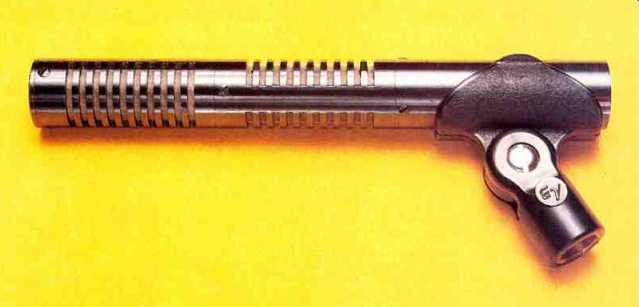
Manufacturer's Specifications:
Frequency Response: 30 Hz to 15 kHz, ±3 dB.
EIA Sensitivity: 1.4 mV/Pa.
Impedance: 200 ohms.
Dimensions: 1 in. diameter x 8 in. L (2.54 cm x 20.32 cm).
Weight: 12 oz. (0.34 kg).
Supplied Accessories:
Shure A55M cushion mount with 5/8-27 thread; cable terminating in twin three-pin XLR-type male connectors.
Price: $800.
Company Address: 1216 Denmark Rd., Plainfield, N.J. 07062.
The Speiden SF-12 is a one-point stereo microphone consisting of two stacked ribbon transducers in a cylindrical case, with the pickup axes fixed at 90°. The ribbon units are open to the atmosphere on both sides and therefore respond to the difference in sound pressure between the two sides. This pressure gradient corresponds to the particle velocity of the air; hence, transducers of this type are called velocity microphones. The ribbon velocity microphone was patented in 1931 by H. F. Olson, and those made by RCA were widely used in radio broadcasting for 30 years there after. (L. J. Anderson was responsible for the practical design of RCA's ribbon mikes from 1929 to 1960, at which time I myself assumed those duties.) Ribbon velocity microphones are noted for having figure-
eight, bidirectional, cosine patterns which are quite independent of frequency in the horizontal plane; this is because ribbon widths are small compared to the wavelength of sound. In the vertical plane, the pattern sharpens at high frequencies because the ribbon is long compared to its width. Olson found that this is a minor problem for pickup of musical performances, because the sources in such cases are in a horizontal plane. The frequency response of a (properly designed) velocity microphone is uniform above the resonance, which is placed at the lowest frequency consistent with mechanical stability of the ribbon.
The twin elements of the SF-12 are arranged so that the pickup axes are perpendicular. With vertical mounting, the top element feeds the left channel and the bottom one feeds the right. The configuration is similar to the B & 0 stereo mike which was popular in the early days of stereo, except that the angle between the elements of the B & 0 was adjustable, and it had bass-cut and inter-element phasing switches in the lower part of its case. I recently had the opportunity to check a 20-year-old B & 0 and found that these adjustments had become unreliable. Thus, I prefer the SF-12, with its fixed settings.
According to the literature furnished by the manufacturer, the SF-12 may be used for X-Y stereo or M-S stereo, the latter requiring a matrix network to retrieve the left and right audio channels. The X-Y arrangement of twin figure-eights at 90° is referred to as a Blumlein array, after the inventor who was experimenting with stereo at the same time as Olson was working on ribbon microphones. This early work has prompted Speiden to use the slogan "a brand-new idea from 1931!" on the catalog sheet. (The interested reader may refer to the July/August 1985 issue of the Journal of the Audio Engineering Society for articles by me, Wes Dooley, and Ron Streicher which describe velocity and coincident stereo microphones as well as how to use them.) The SF-12 is recommended for one-point pickup of entire orchestras or groups of instruments. It should not be used for close-miking because of the bizarre imagery that could result. Another reason is that velocity microphones have a large proximity effect, resulting in exaggerated bass when used close to a source. Velocity mikes must have low-cut equalizers if used close, and the SF-12 has none.
The SF-12 was developed and is being manufactured in limited quantities by Bob Speiden, who operates a recording studio when he isn't making microphones. He patterned the SF-12 after the B & O, eliminating what he judged to be unreliable features and using high-tech materials. I think he has succeeded in converting a consumer microphone de sign into a professional-quality product. I do advise the reader, however, that the Speiden production and test facilities are limited, and they may not be able to handle a sudden, big demand for product or maintenance.
Measurements

Fig. 1-Impedance vs. frequency. The resonances at 60 Hz (top element) and
67 Hz (bottom element) should shift lower and smooth out as the mike ages.
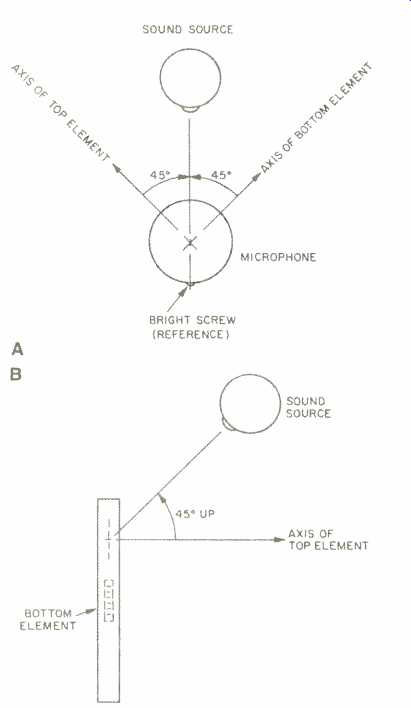
Fig. 2-Geometry for directional tests of frequency response. Note that sound
sources on the microphone's axis are 45° off-axis for both the top element
(A) and the bottom (B).
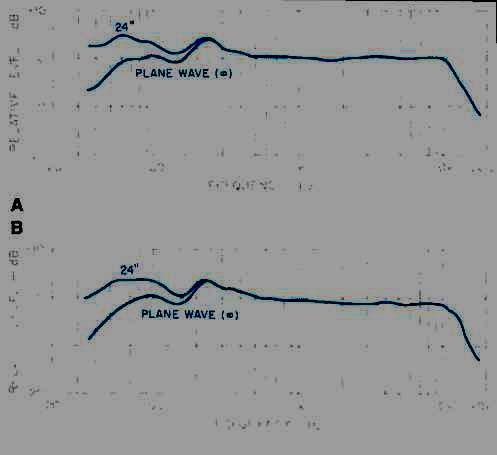
Fig.
3-Axial frequency response of top (A) and bottom (B) elements for plane waves
and for sources 24 inches from the microphone. (0 dB =-59.5 dBV Pa)
Testing a ribbon mike's impedance is the best check on its quality. The resonant frequency and impedance must remain stable when the ribbon is displaced by breath puffs against its edge; failing this test indicates that the element is twisted or is dragging against the gap.
The first SF-12 I tested had one dragging ribbon, which was caused by its resonant frequency being set too low.
The second unit I tested, however, had resonant frequencies between 60 and 70 Hz, as specified (Fig. 1). Speiden is using RCA-type ribbons, which have only transverse corrugations, and such ribbons loosen with aging. (A ribbon design with longitudinal corrugations in the middle and transverse corrugations at the ends, which I believe to be more stable, is used by Beyer.) The SF-12's short ribbon is similar to that of the RCA 77-DX. Experience indicates that its resonance may drift down to the 50-Hz region after a few months, and remain there for many years of dependable operation. The sample mike's impedance curves, shown in Fig. 1, are tolerably well matched and very similar to that of the 77-DX. (A caution to home testers: Resistance testing with an ohmmeter is a major cause of ribbon failure. I test with a very low, constant a.c. current, as described in the April 1977 issue of Audio.) I also must add a note about ribbon soldering: The old RCA ribbons were soldered, and Beyer does this also. Bob Speiden, however, feels that he has selected compatible materials for the clamps and prefers not to solder. Past experience shows that unsoldered ribbon circuits may open over time. Of course, this is not a major problem to repair.
Figure 2 illustrates the geometry involved in acoustical response testing. It is important to note that the bright plated screw (Fig. 2A) defines the back of the microphone, which is opposite the sound source. If the microphone is turned 90°, the outputs will be out of phase.
Figure 3 shows the axial responses of the two elements. (Referring to Fig. 2, note that sounds on either element's axis are 45° from the direction in which the microphone is pointing.) The curves are well matched, within 1 or 2 dB.
The first thing evident is that the responses roll off above a -3 dB point of about 13 kHz. This is related to the path length from the front to the back of the ribbon. If the path length were shortened, the cutoff frequency would rise, but the pressure difference and the output level would de crease. Such a decrease would reduce dynamic range, at least with some mixers, due to preamp noise. Note that, thanks to Speiden's use of the most efficient magnets avail able, the SF-12's measured output level was-59.5 dBV/Pa. This is very close to the low limit of- 60 dBV/Pa for 250-ohm electrodynamic microphones established in my JAES article. I believe the SF-12 to be a state-of-the-art design.
The high-frequency cutoff is a bit lower than the specified 15 kHz. I do not criticize the manufacturer for this, because microphone calibration above 10 kHz is difficult, particularly when one has to compare a ribbon velocity mike to a lab-standard condenser mike. I found the old B & 0 had a cutoff of 11 kHz, so the SF-12 represents an improvement. Also, some readers may remember my August 1980 "Equipment Profile" of the Shure SM-81, a high-quality condenser mike.
Although the Shure's axial response cutoff was shown to be about 16 kHz, the cutoff at 90° was about 11 kHz. In contrast (Fig. 4), the SF-12 maintains at least a 13-kHz cutoff throughout its useful horizontal pickup angle, broadening slightly at 45°. At 90°, where a near-ideal null of about 20 dB is maintained, the cutoff frequency is still the same. The Shure condenser mike, at 180°, did not maintain a uniform null; the curve varied over a 12-dB range. I am willing to trade off a little axial response to gain flatter off-axis response. This is especially important in X-Y stereo pickup, where there is no mike aimed straight at the centrally located performers.
Figure 5 shows that, in the vertical plane, the off-axis responses are less uniform, but not extremely so. I would recommend that you take care to position the SF-12 so that all sources are within about 20° of the axis, vertically.
Figures 3 shows low-frequency responses measured at 24 inches, and the (calculated) plane-wave curves. The response obtained in actual use will probably lie between these curves; I have found that velocity mikes with a bass roll-off for plane waves can make quite good recordings of a pipe organ. The "lump" at 250 Hz is related to the overtone of the ribbon resonance. I think the lump will smooth out and shift to a lower frequency with normal usage over time. The old B & 0 after 20 years had no lumps, and the bass roll-off for plane waves was scarcely evident. However, to keep the lumps within specifications during the break-in period, it might be wise for the manufacturer to add more acoustical-resistance damping.
The phasing of each unit was found to be standard and correct when the bright screw was oriented as shown in Fig. 2. Compared to a Beyer M500 ribbon mike, the SF-12 was very sensitive to wind, and I think a foam screen should be supplied for wind (and dirt) protection. Vibration sensitivity was found to be high; the top unit had a ringing sound at 390 Hz. Ribbon transducers have inherently low vibration sensitivity because of the low mass of the ribbon, but if they are mounted in a housing that "rings," the sound couples acoustically to the ribbon. This can be remedied by applying damping material to the housing. The furnished cushion mount provides adequate isolation. Magnetic hum pickup was very low-as low as the Beyer.
My last test was to measure the frequency response of each channel compared to that obtained with the outputs mixed one-to-one. This was conducted with the bright screw oriented away from the source. The sum curve resembled the curves for the individual units quite well, except it was 6 dB higher in level. Therefore, it would seem the units are phase matched.
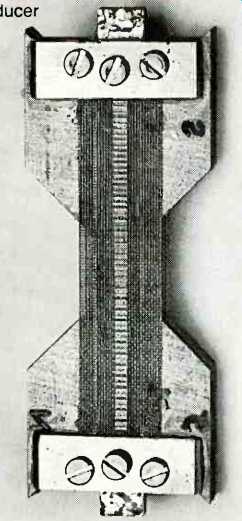
above: Ribbon transducer of the SF-12
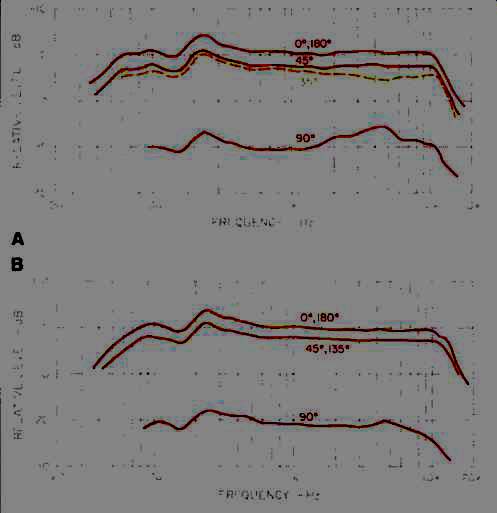
Fig. 4--Frequency response vs. horizontal angle for plane wave, for top (A)
and bottom (B) elements.
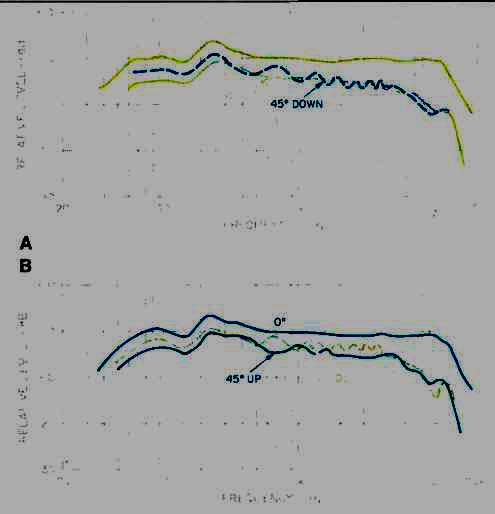
Fig. 5--Frequency response vs. vertical angle for plane wave, for top (A)
and bottom (B) elements.
Use and Listening Tests
I used the SF-12 first as a backup mike to record a Christmas Eve church service on a Revox A77 open-reel tape deck. The reference recording was made on an Aiwa F990 cassette deck with Dolby C NR and HX-Pro, driven by an AKG C-422 stereo microphone set for Blumlein stereo.
(Please note that the C-422 costs $2,650!) While the AKG was flown 20 feet overhead, the Speiden had to be mounted on a floor stand. I used the Shure S-15 stand, which can elevate a mike to 15 feet and is great as a substitute for "flying." Though the AKG is not a low-output mike, I didn't drive the Aiwa's mike inputs directly; the Aiwa has a higher input impedance and lower voltage gain than other recorders I use. I had to use a pair of Jensen transformers with a 200-to-600 ohm step-up. These were mounted in a steel box with XLR-type connectors plus the switches which Jensen recommends to provide a choice of grounding protocols.
For evaluation, all tapes were played into my modified, matched, and equalized Altec 604C studio monitor speakers, in a listening room that closely resembles what is recommended by the IEC. On the church recording, making an effort to ignore the different auditory perspectives, I found that the SF-12 sounded very similar to the C-422. A variety of sound sources was recorded: A brass quintet, a cello, a bell choir, a pipe organ at maximum power output, a choir and soloists, and 1,000 people singing. I concluded that the SF-12 would make a good substitute for the AKG in remote-location recordings, as this would avoid having to fly the mike and take it down again for a temporary setup. It would also be simpler to use properly than a pair of single-channel mikes.
One concert recorded with the Speiden was of a brand new Yamaha grand piano accompanying solo trumpet and flute and assorted vocalists. The second was an operetta presented in concert form, with soloists arranged across the stage and accompanied by piano. The vocals ranged from bass to soprano. Cassette tapes were recorded on the Aiwa as above, again using the pair of Jensen transformers in driving the recorder's mike inputs. I was very pleased with the sound and the very accurate perspectives of both tapes made with the Speiden. Sound was quite transparent; there was no noticeable coloration due to the 250-Hz lump or the 13-kHz cutoff. (Actually, I do not hear well above 13 kHz!) In fact, I prefer the sound of these cassettes to any mass produced LP or CD recording I've heard. Many commercial recordings are multi-miked; as a result, they have no real stereo perspective, especially when compared to recordings made with a single stereo microphone.
I have a word of caution about using the SF-12 or Blumlein arrays in general: The included angle of 90°, as compared to the 120° recommended for X-Y cardioids, means that the Blumlein should be farther from the sources to obtain similar perspectives and direct versus reverberant sound. I had difficulty in positioning the Speiden far enough from the performers, because the rear lobes picked up audience noise. In two cases, to reduce noise I had to select a compromise location, which resulted in slightly exaggerated perspectives and less room sound.
Conclusions
I find that in applications where figure-eight patterns are desired, the SF-12 is an excellent, comparatively low-cost, portable substitute for the C-422. It has the traditional ribbon advantage of "condenser quality" without the aggravations of powering and the possibilities for sputtering or failure in damp environments. I think it could serve as a music-recording mike for anyone with a cassette recorder who does not want to carry a mixer and several mikes and stands. For the audiophile, a stereo mike will offer a better chance of making a good tape in live situations where you can't experiment. I think the SF-12 would be great for live, on-site taping for the person who only wants to use two tracks and two mike inputs. I recommend the SF-12 to everyone who owns a quality cassette or open-reel recorder.
-Jon R. Sank
==============
COUNTERPOINT: A CLASSIC MIKE
The Speiden SF-12 was used to record a concert by the Princeton Pro Musica in Richardson Auditorium at Princeton University. The program consisted of works for a cappella choir, Schubert's Fifth Symphony, and Beethoven's "Mass in C" with full orchestra, chorus, and four soloists.
Both as a recording engineer and as an amateur choir singer, I have been frustrated for some time in trying to find the right microphone to record the human voice, especially the unique, massed sound of a large choir. The frequency response characteristics of even the best condenser mikes, to my ears, add an unnatural edge to the vocal sound and tend to exaggerate such consonants as "t" and "s." While this type of sound has come to be commercially acceptable, I have never been quite satisfied with it. The SF-12 had none of these problems. The sound of the choir was very smooth and natural, but at the same time there was no apparent loss of highs in the sounds of the violins or trumpets.
It is often difficult to place a Blumlein (crossed figure-eight) mike like the Speiden SF-12 so as to achieve proper balance between direct sound from the musicians and reverberant sound from the concert hall. If the microphone is placed too close to the stage, the resulting sound can be too dry; too far from the stage, and you lose presence and definition. The best solution is to have a good hall. As luck would have it, this was the case at Richardson Auditorium. The hall (which accommodates approximately 800 people) has a high, vaulted ceiling and curved walls interspersed with tall Greek columns; this results in a smooth reverberation time of about 2.5 sec.
The SF-12 was placed 16 feet above the stage, about 3 feet behind the conductor. The mike was tilted downward by about 30° to improve stage presence and slightly reduce pickup of reverberant sound. The resulting balance in the Beethoven was virtually ideal, even though the choir was located behind the orchestra, more than 30 feet from the mike. Stereo placement was excellent, with the first violins firmly on the left, and cello and bass on the right along with the soloists. Despite the choir's distance from the mike, the vocal distribution could be easily perceived, with the sopranos on the left, altos on the right, tenors and basses in the center.
Unlike past ribbon-mike designs, the Speiden has quite a high output level, about the same as the average dynamic mike's. I had no problem using the SF-12 with my home open-reel deck.
The recording was equal to anything I've heard made with the best professional equipment.
The SF-12 is the ideal microphone for the serious audio amateur or professional who wishes to use a minimum of mikes; for its price, it is a real bar gain. Amazing as it may seem, the SF-12 is the only true Blumlein micro phone made in the world today. Bob Speiden deserves our thanks for making this classic microphone design available again.
-Charles P. Repka
==============
(Source: Audio magazine, Mar. 1987)
Also see: Beyerdynamic Model M500N (C) Microphone (Feb. 1978)
Brüel & Kjaer Type 4003 and Type 4007 Studio Condenser Microphones (Nov. 1984)
Brüel & Kjaer 4011 Studio Microphone (Jan. 1990)
Crown PZM-180 Pressure Zone Microphone (March 1985)
Nakamichi Model CM-700 Electret Condenser Microphone Systems (Sept. 1978)
Neumann Models 83, 84, & 85 fet-80 Series Microphone System (Jan. 1978)
= = = =